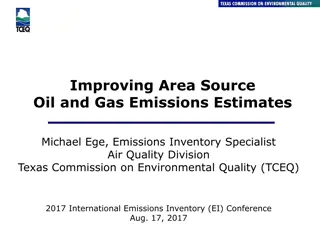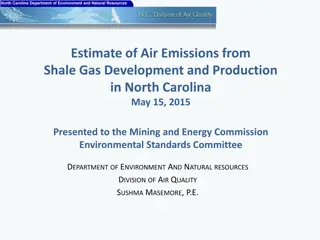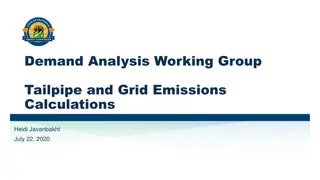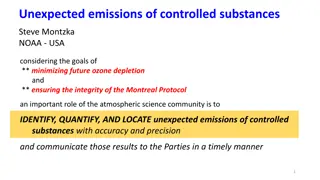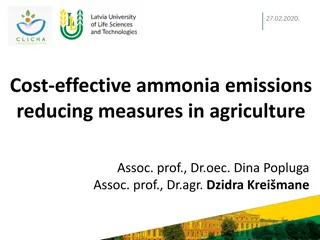
Emission Designators and Their Importance in Frequency Coordination
Learn all about emission designators, how they classify radio waves, decode their symbols, and understand their importance in technology and interference protection for radio communications.
Download Presentation

Please find below an Image/Link to download the presentation.
The content on the website is provided AS IS for your information and personal use only. It may not be sold, licensed, or shared on other websites without obtaining consent from the author. If you encounter any issues during the download, it is possible that the publisher has removed the file from their server.
You are allowed to download the files provided on this website for personal or commercial use, subject to the condition that they are used lawfully. All files are the property of their respective owners.
The content on the website is provided AS IS for your information and personal use only. It may not be sold, licensed, or shared on other websites without obtaining consent from the author.
E N D
Presentation Transcript
Emissions Designators All about Emissions And why they are important To frequency coordination
Decoding an Emissions Designator Emissions are designated according to their classification and their necessary bandwidth. A minimum of four symbols are used to describe the basic characteristics of radio waves. Emissions are classified and symbolized according to the following characteristics: First 4 Characters occupied bandwidth of the modulation. Fifth Character type of modulation Sixth Character nature of the signal modulating the carrier. Seventh Character Type of information
An Example 11K0F3E 11K0 Occupied Bandwidth Bandwidth: H - Hertz K Kilohertz F 3 E Type of Modulation Modulation F Frequency Nature of the Signal Type of signal 1 Digital 3 Analog 7 Composite Channel X -- Cases not otherwise covered Type of information Type of Information D Data E Voice W Combination
So why are emission Designators important? With the increasing use of narrowband channels and interstitial channels, the designators tell us what technology is being used. The technology determines what protection from interference is needed. Mostly derated contour values are used, but for some cases a SARD study is used.
Definitions Occupied bandwidth (RR No. 1.153) The width of the frequency band which is just sufficient such that, below the lower and above the upper frequency limits, the mean powers emitted are each equal to a specified percentage /2 of the total mean power of a given emission. Unless otherwise specified in an ITU-R Recommendation for the appropriate class of emission, the value of /2 should be taken as 0.5%. Necessary bandwidth (RR No. 1.152) For a given class of emission, the width of the frequency band which is just sufficient to ensure the transmission of information at the rate and with the quality required under specified conditions. 90.209 (a) Each authorization issued to a station licensed under this part will show an emission designator representing the class of emission authorized. The designator will be prefixed by a specified necessary bandwidth. This number does not necessarily indicate the bandwidth occupied by the emission at any instant. In those cases where 2.202 of this chapter does not provide a formula for the computation of necessary bandwidth, the occupied bandwidth, as defined in part 2 of this chapter, may be used in lieu of the necessary bandwidth.
Typical Designators 11K0F3E, 11K2F3E, 11K3F3E FCC considers all three of these to be identical. Narrow FM Voice 11KxF1D narrow FM data not needed unless you have a low-speed data system. 20K0F3E wide FM Voice 14K0F3E NPSPAC 4kHz FM Voice
Typical Designators 8K10F1E - P25 phase I voice 8K70D1W P25 LSM modulation (Base Station Only) 9K80D1E Phase II Outbound Modulation (WCQPSK) 7K60FXE, 7K60FXD 2 slot DMR voice - data
Invalid Designators F9W Combination digital and analog modulation Some license application preparers have used the suffix F9W to indicate that multiple different emissions within the specified bandwidth are possible. This simplifies filling information into the FCC 601 form and many foreign agencies' forms, but does not reflect each specific modulation type. For example, 11K2F9W may indicate that the system toggles between narrowband analog voice and P25 (or some other) digital emission, but not at the same time. A strict interpretation of ITU emissions indicates that the F9W suffix is both analog and digital simultaneously, and is therefore incorrect. A properly completed form should itemize each discrete emission intended so the technologies used may be easily identified. 15K - I ve seen this on a couple of applications, but I can t find any technology that would use that designator.
Carsons Rule A very useful rule of thumb used by many engineers to determine the bandwidth of an FM signal for radio broadcast and radio communications systems is known as Carson's Rule. This rule states that 98% of the signal power is contained within a bandwidth equal to the deviation frequency, plus the modulation frequency doubled. Carson's Rule can be expressed simply as a formula: 2( F + f mod) F Frequency Deviation F mod Modulation frequency generally this 3kHz
Why is it important to use correct designator? For many frequency bands the designator is used in the coordination process. The designator is used to select which derating contour to use for interstitial frequencies. For T-band the designator is used for TSB-88 interference studies. For NPSPAC and 700 MHz Regional planning the designator is needed to ensure the interference studies are done correctly.
Link to more information https://wiki.radioreference.com/index.php/Emission_Desi gnator










